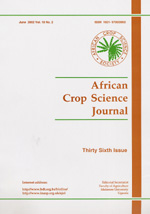
|
African Crop Science Journal
African Crop Science Society
ISSN: 1021-9730
EISSN: 1021-9730
Vol. 5, No. 4, 1997, pp. 359-369
|
 Bioline Code: cs97042
Bioline Code: cs97042
Full paper language: English
Document type: Research Article
Document available free of charge
|
|
|
African Crop Science Journal, Vol. 5, No. 4, 1997, pp. 359-369
| en |
On-farm evaluation of an animal-drawn implement developed in Ethiopia for row placement of wheat seed and basal fertiliser
Taa, Asefa; Tanner, D.G.; Temesgen, Melesse & Girma, Kefyalew
Abstract
Grass weeds are difficult to control by hand weeding in a broadcast wheat
crop because several species are not easily distinguished from the crop at
an early stage. Chemical weed control, on the other hand, can be highly
effective, but is limited in Ethiopia by the unavailability and high cost
of herbicides. Further, dependence on high efficacy herbicides to control
grass weeds can result in weed species shifts and/or the development of
resistant weed biotypes. Row sowing of wheat can facilitate hand and/or
mechanical weeding by enabling farmers to identify grass weeds in the
inter-row spaces. However, manual row seeding is extremely labour intensive
and unacceptable to peasant farmers in Ethiopia. Row seeders developed
elsewhere have not been accepted in Ethiopia because they were either too
labour inefficient or ineffective in cloddy and rough fields. Therefore, a
four-row seeder has been developed in Ethiopia with a new type of seed
metering mechanism. Field tests have shown that the row seeder can work
effectively in fields prepared by ox plough. The row seeder is labour
efficient, requiring less than 25% of the time per unit area compared to
the farmers' conventional practice of broadcasting seed and fertilizer and
covering by ox plough. The seeder also facilitates placement of seed and
fertilizer together in the row, enabling the crop to utilise fertiliser
more effectively and limiting the nutrients available to weeds emerging
between crop rows. In one season, use of the row seeder increased wheat
grain yield by 28% in comparison to the conventional broadcasting. The row
seeder used in conjunction with an inter-row weeder was the most profitable
package tested on farmers' fields in 1995 and 1996, representing a
sustainable production technology for peasant wheat farmers in Ethiopia.
Keywords
Animal traction, on-farm research, seeder, sowing, weed control, wheat
|
| |
| fr |
Taa, Asefa; Tanner, D.G.; Temesgen, Melesse & Girma, Kefyalew
Résumé
Les mauvaises herbes sont difficiles a controler par desherbage manuel dans
un champ de ble seme a la volee, car plusieurs d'entre elles ne sont pas
facilement differenciables de la culture a un stade precoce. Par contre, le
desherbage chimique peut etre tres efficace. Neanmoins, il est restreint en
Ethiopie par l'indisponibilite et le cout eleve des herbicides. De plus,
dependre d'herbicides tres efficaces pour le controle des mauvaises herbes
peut entrainer un changement dans la frequence des especes adventices et/ou
le developpement de biotypes de mauvaises herbes resistants. Le semis en
rangs du ble peut faciliter le desherbage manuel et/ou mecanique en
permettant au cultivateur d'identifier les mauvaises herbes dans les
espaces entre rangs. Cependant, le semis manuel en rangs est extremement
laborieux et inacceptable par les paysans fermiers d'Ethiopie. Les semoirs
a rangs mis au point ailleurs, n'ont pas ete adoptes en Ethiopie parce
qu'ils etaient soit inefficaces au travail, soit ineffectifs dans les
champs a mottes ou accidentes. Par consequent, un semoir a 4 rangs avec un
nouveau type de mecanisme de comptage de graine, a ete mis au point en
Ethiopie. Des essais au champ ont montre que ce semoir a rangs peut
fonctionner efficacement dans des champs prepares a la charrue a boeufs. Le
semoir a rangs travaille efficacement, necessite moins de 25% du temps par
unite de terrain par rapport aux pratiques conventionnelles du cultivateur,
qui consistent a semer a la volee, a fertiliser et a couvrir avec la
charrue a boeuf. Le semoir facilite egalement la mise en place de la graine
et de l'engrais ensemble dans le rang, permettant a la culture d'utiliser
plus efficacement l'engrais et de restreindre les substances nutritives
disponibles aux mauvaises herbes emergeant entre les rangs. L'utilisation
du semoir a rangs durant une saison a augmente les rendements en grains du
ble de 28% par rapport au semis a la volee conventionnel. Le semoir a rangs
utilise conjointement a un sarcloir entre les rangs etait la strategie la
plus avantageuse testee chez le cultivateur en 1995 et 1996, representant
une technologie de production durable pour les paysans cerealiculteurs
d'Ethiopie.
Mots Clés
Ble, desherbage, recherche en exploitation, semis, semoir, traction animale
|
| |
© Copyright 1997 - African Crop Science Society
|
|
